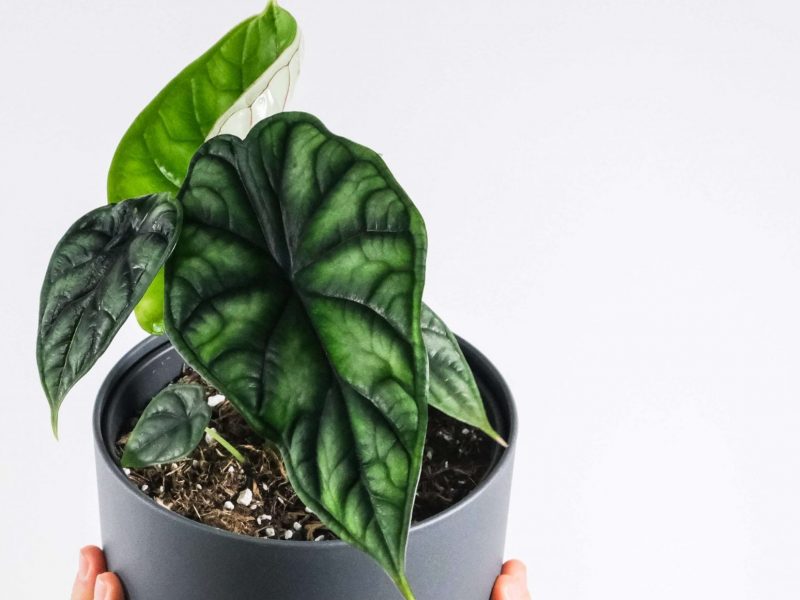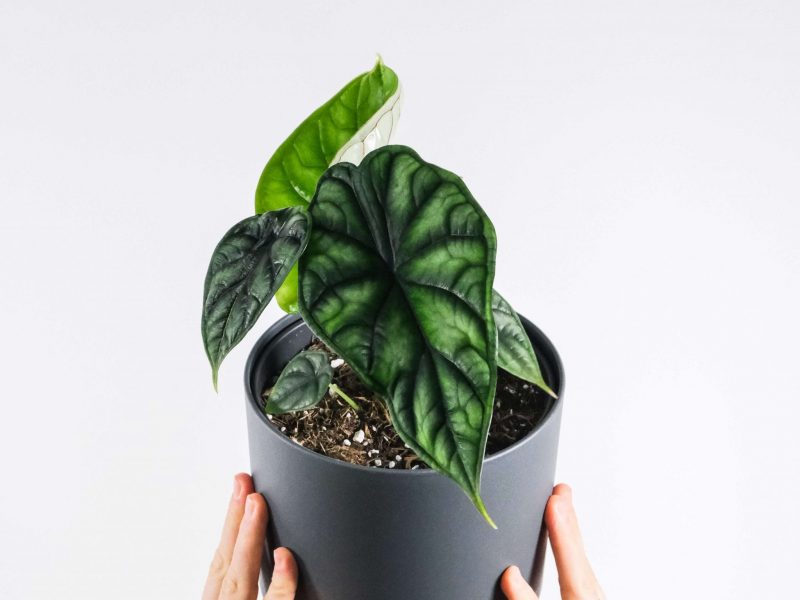
These once very rare houseplants are starting to crop up more and more across the world and we couldn’t be happier about it. Although they often aren’t as sensitive and susceptible to issues compared to a lot of other plant types out there, this doesn’t mean that you won’t run into any problems. One of the most common is curling or wrinkled leaves which is commonly one of the earlier signs of trouble.
Below we will go through each of the possible causes of curling and wrinkling leaves on an Alocasia Dragon Scale as well as guide you through the diagnosis and treatment processes. Your plant will be back to its normal self in no time.
Underwatering can often cause curling or wrinkled leaves
If the leaves on your Alocasia Dragon Scale are starting to develop brown tips, edges, spots or entire leaves are turning brown as well as curling or wrinkling, then it may be due to underwatering. However, as this is an early sign of trouble, don’t disregard this if curled leaves are the only symptom.
It’s important that you check the soil before you change anything about how much or how often you water your plant! You want to make sure the soil definitely is dry before giving it more water as otherwise, this can cause more issues than the curling or wrinkled leaves.
The most reliable way to check the moisture levels in the soil is by using a moisture meter. They are really affordable little devices that you pop into the soil and they will tell you how damp or dry the soil is. We always recommend this one from Amazon. You may also want to remove your plant from its pot to inspect the soil and this will also give you the opportunity to take a look at the root system. If the issue of underwatering has been going on for a while, then the roots may have started to dry out and crisp up.
Your first reaction to fixing an underwatered Alocasia Dragon Scale might be to pour endless amounts of water on it to make up for a lack of it previously. However, this can actually be damaging to your Alocasia Dragon Scale as they can get shocked and stressed if their environment drastically goes from one extreme to the other. Instead, the best thing to do is gradually introduce water over the course of the next week.
To prevent underwatering from causing more curling leaves in future (or any other serious issues), it’s vital that you increase the frequency or amount of watering. You want to prevent the soil from fully drying out for extended periods of time. Self-watering pots can be useful if you find yourself forgetting a lot or if you are often on holiday for extended periods of time.
Low humidity might also be to blame
Aside from moisture in the soil, low moisture in the air can also cause curling or wrinkled leaves on your Alocasia Dragon Scale. This can also show up as brown leaf tips or edges so that’s another thing to look out for.
But don’t worry, if the curling leaves are caused by a lack of humidity then there are some really easy and cheap solutions that will instantly get your Alocasia Dragon Scale looking and feeling fresher.
Get into a misting routine
Misting the leaves is one of the easiest ways to increase the humidity for your Alocasia Dragon Scale and can really help solve the issue of curling leaves and prevent any more brown leaf tips from developing.
Give your Alocasia Dragon Scale a shower
One really simple thing you can do to instantly boost the humidity for your Alocasia Dragon Scale and stop the leaves curling or wrinkling is showering your plant. Although this is a more short-term solution, it’s also a great way to remove dust from the leaves which is a bonus. You just want to make sure to keep the water pressure relatively low to avoid breaking any of the leaves or stems.
Think about changing the placement
If you have good light levels (and enough space) in your kitchen or your bathroom then it could be a good idea to move your plant in there. The reason for this is that the humidity levels are naturally slightly higher in these rooms because of the steam released when showering and cooking.
Top tip: Just make sure that your plant is at least one meter away from the cooker to avoid the leaves drying out.
Buy a humidifier
If you want to take all the worries away from keeping a steady humidity level for your Alocasia Dragon Scale and prevent more curled up leaves, then buying a humidifier is definitely the best option for you. They can be really affordable and your dry air worries will be gone in a flash!
Curling leaves can be caused by intense direct sunlight
Whilst Alocasia Dragon Scales need bright light to thrive it’s crucial that this light is indirect. Intense sunlight (especially in summer) can dry out and scorch the leaves, causing yellow and brown patches and eventually plant death). However, one of the earlier signs of distress caused by direct light is curling leaves or the leaves looking somewhat wrinkled.
This can very quickly cause their leaves to begin curling inwards which happens for two reasons. Firstly, it is a mechanism that a lot of plants use to avoid moisture loss which can happen quickly when the leaves are dried out by intense hot sunlight. The second reason plants can start curling or wrinkling their leaves is to protect themselves from direct sunlight by minimising their light exposure.
If you have caught the issue fairly early and the only sign of unhappiness are the curled leaves, then the issue should resolve itself by moving your Alocasia Dragon Scale to a shadier spot in your home. However, if your plant has developed yellow or brown patches then these are irreversible and we recommend trimming the worst affected leaves off your plant.
Cold temperatures can also cause the leaves to curl
Make sure that you draft-proof any windows/ doors that are close to your Alocasia Dragon Scale (and other tropical or heat-loving houseplants) as the constant flow of cold air from outside during winter can be super damaging to your plant. Not only can it cause curling or wrinkled leaves but you may also spot discoloured spots on the leaves, droopy stems, stagnant growth and even leaf drop.
But it’s not just winter that causes havoc with your plants as air conditioning units can be quite damaging as well. The constant flow of cold air might be refreshing to you but it can actually begin to slowly freeze the leaf tissue if your plant gets too cold.
If your Alocasia Dragon Scale is in quite a cool room, this can also increase the risk of overwatering and root rot which is best avoided at all costs! Your Alocasia Dragon Scale won’t need as much water as the soil will take a lot longer to dry out in cooler temperatures. This can be the perfect place for root rot and leaf rot to occur so be extra cautious when it comes to caring for your Alocasia Dragon Scale in winter or in colder rooms in your home.
You may be overfertilizing your Alocasia Dragon Scale
Another cause of curling leaves on an Alocasia Dragon Scale is over-fertilisation. This is a tricky one to diagnose because it’s difficult to test the soil but if none of the other issues fit with your plant and you have been heavily feeding them recently, then this might be the answer.
We recommend fertilising using a water-soluble fertiliser at a lower than recommended strength every month or so during spring and summer. Hold off giving any fertiliser during the winter months as your Alocasia Dragon Scale will not be producing any new growth and this can kill your plant.
To solve the issue, flush out the soil or replace it entirely as well as remove any fertiliser spikes and hold off fertilising for at least 6 months to allow your plant time to recover.
We hope that this guide to curling Alocasia Dragon Scale has been helpful and that you have been able to successfully diagnose the issue. We recommend going through the list one by one whilst inspecting your plant’s leaves, stems, roots and potting mix to figure out what is happening to your plant.
Check out our Alocasia Dragon Scale care guide to discover more about how to keep your plant thriving.














